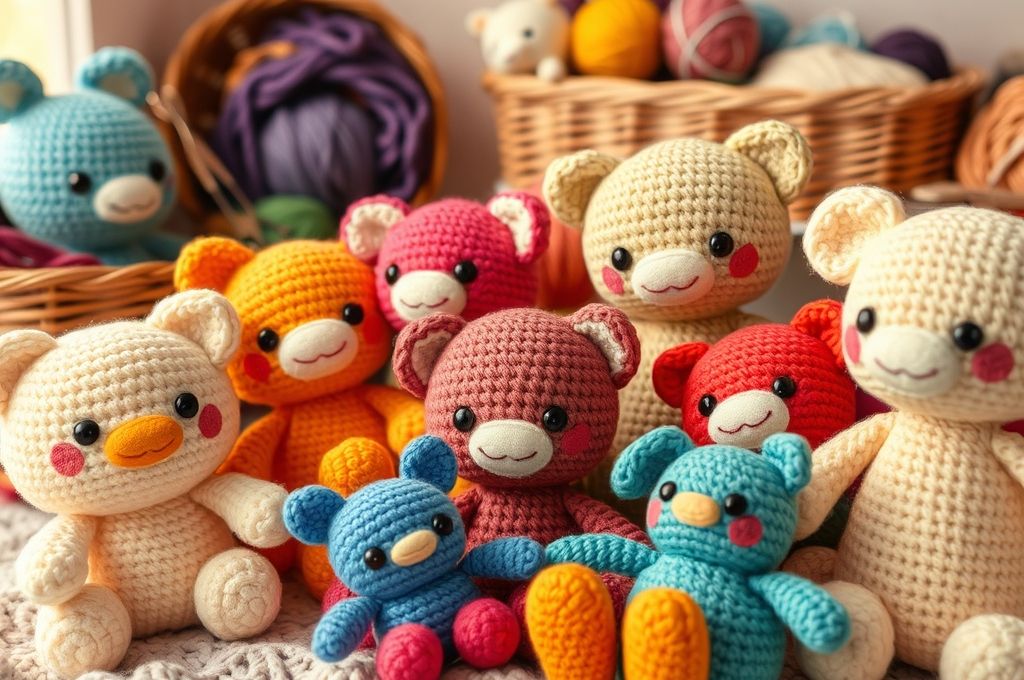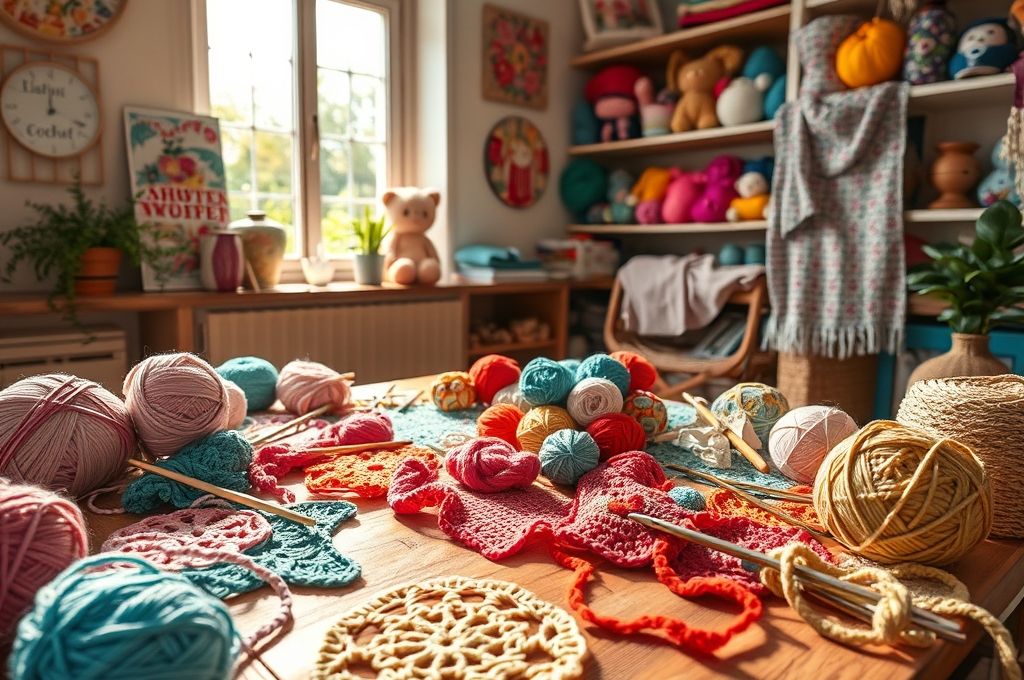The Magic of Tiny Crocheted Wonders
Have you ever held something so small, so soft, and so full of charm that it instantly melted your stress away? That’s the magic of amigurumi—a Japanese art form that turns simple yarn and a crochet hook into adorable, huggable creatures. From wide-eyed bunnies to sleepy sloths and mischievous monsters, amigurumi toys are more than just handmade crafts; they’re tiny bursts of joy, each one stitched with care and personality.
Amigurumi (pronounced ah-mee-goo-roo-mee) blends the Japanese words ami, meaning “crocheted or knitted,” and nuigurumi, meaning “stuffed doll.” While the craft has roots in Japan, it’s taken the world by storm, captivating crafters of all ages and skill levels. Whether you’re a seasoned crocheter or someone who’s never picked up a hook, amigurumi offers a delightful way to create, relax, and even gift a piece of handmade love.
In this article, we’ll dive into the whimsical world of amigurumi, exploring why it’s more than just a craft trend. You’ll learn about its origins, the mental and emotional benefits of making these tiny treasures, beginner-friendly tips to get started, creative ideas for your next project, and how amigurumi can spark joy in everyday life. So grab a cup of tea, cozy up, and let’s unravel the cozy, colorful world of cute and cuddly crochet toys.
The Origins and Evolution of Amigurumi
To truly appreciate amigurumi, it helps to understand where it came from. Though crocheting and knitting have existed for centuries, the modern amigurumi style as we know it began gaining popularity in Japan in the early 2000s. Japanese crafters began creating small, stylized animals and characters using tight crochet stitches and safety eyes, giving them a distinctive, cartoon-like appearance.
What set amigurumi apart was its focus on cuteness—or kawaii—a cultural aesthetic deeply embedded in Japanese pop culture. Think big eyes, round heads, and tiny limbs. These features aren’t just charming; they trigger a psychological response known as baby schema, where exaggerated infant-like traits evoke feelings of warmth and care. That’s why even a crocheted octopus with three eyes can make your heart skip a beat.
Over time, amigurumi evolved beyond Japan. Craft blogs, YouTube tutorials, and platforms like Etsy and Ravelry helped spread the trend globally. Today, you’ll find amigurumi-inspired patterns for everything from Pokémon characters to realistic-looking food (yes, crocheted avocados are a thing). The craft has also become a creative outlet for self-expression, with artists designing original characters that reflect their personalities or tell stories.
One of the most beautiful aspects of amigurumi’s evolution is its accessibility. Unlike complex knitting patterns or large-scale quilting, amigurumi projects are often quick, portable, and require minimal materials. This makes them perfect for beginners—and perfect for gifting. A handmade amigurumi bear might only take a few hours to make, but the smile it brings? Priceless.
So, whether you’re drawn to its cultural roots, its therapeutic value, or simply the joy of making something adorable, amigurumi is more than a hobby. It’s a global movement of creativity, comfort, and connection.
Why Amigurumi Is More Than Just a Craft

At first glance, amigurumi might seem like just another crafting trend. But dig a little deeper, and you’ll find it’s packed with emotional, mental, and even physical benefits. In fact, many people who start crocheting amigurumi for fun soon discover it’s also a powerful tool for well-being.
Let’s talk about mindfulness. The repetitive motion of crocheting—inserting the hook, pulling the yarn, looping—creates a rhythm that can be incredibly calming. It’s similar to meditation, where your focus narrows to the present moment. Studies have shown that repetitive, rhythmic activities like knitting and crocheting can reduce cortisol levels, the hormone linked to stress. For many, amigurumi becomes a daily ritual of peace in a chaotic world.
Then there’s the sense of accomplishment. Finishing a tiny crocheted fox or a sleepy owl gives you a tangible result of your effort. That little creature on your shelf? It’s proof that you made something beautiful with your own hands. For people dealing with anxiety or low self-esteem, this boost in confidence can be transformative.
Amigurumi also fosters connection. Whether you’re making a toy for a child, gifting a friend a custom character, or joining an online crochet community, the craft brings people together. During the pandemic, many turned to amigurumi as a way to stay connected—sending handmade gifts to loved ones when they couldn’t visit in person.
And let’s not forget the creative freedom. Unlike rigid patterns or functional items like sweaters, amigurumi encourages playfulness. Want a unicorn with rainbow wings and polka-dot hooves? Go for it. The rules are loose, and the imagination is the limit.
In short, amigurumi isn’t just about making toys. It’s about making meaning—through creativity, care, and connection. It’s a small act of love, both for yourself and for others.
Getting Started: Your First Amigurumi Project
Excited to try amigurumi? The good news is, you don’t need years of experience or a mountain of supplies. With just a few basics, you can create your first adorable critter in no time.
What You’ll Need:
- Yarn: Medium-weight (worsted) cotton or acrylic yarn works best for beginners. Choose soft, washable yarn in colors that make you happy.
- Crochet Hook: A 3.5mm or 4mm hook is ideal for most amigurumi patterns.
- Stitch Marker: A small ring or piece of yarn to mark the beginning of each round.
- Tapestry Needle: For weaving in ends and sewing parts together.
- Fiberfill: Soft stuffing for your toy.
- Safety Eyes or Embroidery Floss: For adding expressive eyes and facial details.
Basic Stitches to Know: Most amigurumi is worked in continuous rounds using single crochet (sc) stitches. You’ll also use techniques like:
- Magic Ring (or Magic Loop): A way to start your project with a tight, closed center—perfect for round heads and bodies.
- Increase (inc): Two single crochets in one stitch to make your piece grow outward.
- Decrease (dec): Combining two stitches into one to shape curves and limbs.
Beginner-Friendly Project Idea: A Simple Amigurumi Ball (or “Ami Sphere”)
Start by mastering the basic sphere. It’s the foundation for heads, bodies, and even tiny planets! Here’s a quick pattern:
- Magic ring, 6 sc into ring (6)
- Inc in each stitch around (12)
- Sc 1, inc around (18)
- Sc 2, inc around (24)
- Sc 3, inc around (30) 6-10. Sc in each stitch around
- Sc 3, dec around (24)
- Sc 2, dec around (18)
- Sc 1, dec around (12)
- Dec around (6), fasten off and close.
Stuff it lightly, and voilà—your first amigurumi shape! Once you’ve got this down, you can add arms, legs, ears, and faces to turn it into a character.
The key? Don’t aim for perfection. Your first project might be lopsided or a little messy—and that’s okay. Every stitch is part of your learning journey.
Creative Ideas to Spark Your Imagination

Once you’ve mastered the basics, the real fun begins: designing your own amigurumi world. The beauty of this craft is that there are no limits—only yarn, a hook, and your imagination.
Want inspiration? Here are a few creative directions to explore:
1. Nature-Inspired Creatures
Think hedgehogs with acorn hats, sleepy foxes curled up in leaves, or a family of mushrooms with tiny faces. These make wonderful garden-themed decorations or gifts for nature lovers.
2. Foodie Friends
Crocheted sushi, donuts, or even a grumpy avocado with arms and legs—food amigurumi is wildly popular and endlessly fun. They’re perfect for kitchen decor or as quirky keychains.
3. Fantasy & Mythical Beings
Unicorns, dragons, and mermaids are classic favorites. But why stop there? Create a three-eyed space alien, a friendly ghost, or a griffin with rainbow feathers.
4. Pet Portraits
Turn your real-life furry (or scaly) friend into a crocheted version. Use their actual colors and markings to make a personalized keepsake.
5. Seasonal & Holiday Themes
From jack-o’-lanterns and reindeer to Easter bunnies and snowmen, amigurumi is perfect for holiday crafting. Make a set each year and start a tradition.
6. Miniature Scenes
Go beyond single toys. Create a tiny picnic with a crocheted basket, sandwiches, and a smiling ant. Or build a mini aquarium with fish, coral, and a treasure chest.
Pro Tip: Keep a sketchbook or digital folder of ideas. Jot down characters you see in dreams, favorite book characters, or even funny doodles. Over time, you’ll build a library of original designs.
And remember: imperfections add charm. A slightly crooked eye or uneven limb doesn’t ruin a toy—it gives it character. In fact, many collectors love “wonky” amigurumi because they feel more handmade and heartfelt.
The Joy of Gifting Handmade Amigurumi
There’s something incredibly special about giving a handmade gift. Unlike something bought from a store, a crocheted amigurumi carries a piece of your time, energy, and love. It says, “I thought of you. I made this just for you.”
Amigurumi makes perfect gifts for so many occasions:
- Birthdays: A custom character based on the recipient’s favorite animal or hobby.
- Baby Showers: Soft, safe toys (with embroidered eyes instead of plastic ones) are cherished keepsakes.
- Holidays: A tiny reindeer or snowman adds handmade charm to any gift exchange.
- Sympathy or Care Packages: A soft toy can offer comfort during tough times.
- Teacher Appreciation: A cute apple or owl with a note of thanks.
But the joy isn’t just for the recipient. Gifting amigurumi strengthens relationships. When someone receives a handmade toy, they often keep it for years—on a shelf, in a child’s bed, or even passed down through generations. It becomes a story, a memory, a symbol of care.
And if you’re worried about time, remember: small doesn’t mean insignificant. A 4-inch bunny might take only 2-3 hours to make, but its emotional impact can last a lifetime.
You can even turn gifting into a tradition. For example:
- “Each year, I make my niece a new amigurumi animal that matches her age—she’s 7, so this year it’s a sloth!”
- “I made my partner a crocheted version of our dog for our anniversary.”
These personal touches turn amigurumi from a craft into a language of love.
Amigurumi as a Gateway to Mindful Living
In our fast-paced, screen-filled lives, finding moments of stillness can feel impossible. That’s where amigurumi shines as more than just a creative hobby—it becomes a practice of mindful living.
Think about it: when you’re crocheting a tiny penguin, you’re not checking emails, scrolling social media, or worrying about tomorrow’s to-do list. You’re focused on the loop of yarn, the rhythm of your hook, the shape forming in your hands. This is mindfulness in action—being fully present in the moment.
Research supports this. A 2013 study published in The British Journal of Occupational Therapy found that 81% of people who knit or crochet reported feeling calmer and happier after crafting. Many described entering a “flow state,” where time seems to disappear and worries fade.
Amigurumi enhances this effect because of its small scale and achievable goals. Unlike a blanket that takes months, an amigurumi toy can be completed in a weekend—or even a single evening. This creates a cycle of small wins, boosting mood and motivation.
It’s also a form of digital detox. No algorithms, no notifications—just you, your yarn, and your imagination. Many crafters report that their amigurumi time becomes their favorite part of the day, a peaceful ritual they look forward to.
And for those dealing with anxiety, depression, or chronic pain, amigurumi can be a gentle, non-invasive way to manage symptoms. The tactile sensation of yarn, the visual satisfaction of seeing progress, and the emotional reward of creation all contribute to a sense of well-being.
So, the next time you feel overwhelmed, consider picking up a hook and making a tiny turtle. You might just find that the smallest creations bring the biggest peace.
Building a Community Through Amigurumi
One of the most beautiful surprises of starting amigurumi is discovering the vibrant, welcoming community that surrounds it. From local craft circles to global online forums, amigurumi lovers are some of the most passionate and supportive crafters around.
Platforms like Ravelry, Instagram, and Reddit’s r/amigurumi are filled with photos, patterns, and encouragement. You’ll find:
- Free patterns shared by generous designers.
- Step-by-step video tutorials for tricky techniques.
- Challenges and crochet-alongs (CALs) to keep you inspired.
- Friendly feedback and troubleshooting help.
Many crafters also join Facebook groups or Discord servers where they share WIPs (works in progress), celebrate finished projects, and even organize charity drives—like making amigurumi toys for children in hospitals.
And let’s not forget Etsy and craft fairs, where independent artists sell their original designs. Buying from small creators supports handmade art and often comes with a personal touch—like a handwritten note or a custom request.
But the real magic happens in the shared language of creativity. When you post a photo of your wonky little cat, and someone comments, “I love how its ears are different sizes—it gives it so much personality!”—that’s connection. That’s community.
Even if you never sell a piece or join a group, knowing that millions of people around the world are crocheting tiny creatures at this very moment can be incredibly comforting. You’re part of something bigger—a global tapestry of kindness, creativity, and cuteness.
Amigurumi for a Cause: Crafting with Heart
Amigurumi isn’t just about personal joy—it can also be a force for good. Around the world, crafters are using their skills to make a difference.
Charity Projects:
- Project Amigurumi: A global initiative where crafters make toys for children in need, from refugee camps to hospitals.
- Knit-a-Square: While focused on knitting, many amigurumi artists contribute soft toys to accompany handmade blankets.
- NICU Toys: Some hospitals accept small, safe amigurumi toys (without plastic parts) for babies in neonatal units, giving parents a comforting keepsake.
Fundraisers: Craft fairs, online auctions, and donation-based patterns help raise money for causes like mental health, animal shelters, and disaster relief. A single crocheted sloth might raise $20 for a nonprofit—imagine what a whole army of amigurumi could do.
Therapy & Education: Amigurumi is used in occupational therapy to improve fine motor skills and hand-eye coordination. In classrooms, teachers use it to teach math (counting stitches), patience, and creativity.
When you make amigurumi with purpose, your craft becomes more than a hobby—it becomes a gift of time, talent, and heart.
Conclusion: Stitch by Stitch, Joy by Joy
Amigurumi is more than just cute crocheted toys. It’s a journey of creativity, mindfulness, and connection. From the first loop of yarn to the final embroidered smile, every step is an act of care—whether you’re making something for yourself, a loved one, or a stranger in need.
We’ve explored its origins in Japan, its mental health benefits, beginner tips, creative possibilities, and the joy of gifting and community. But more than anything, amigurumi reminds us that small things matter. A tiny crocheted heart, a lopsided bunny, a monster with too many arms—these aren’t just toys. They’re symbols of patience, love, and the quiet magic of making something with your hands.
So, what are you waiting for? Pick up a hook, choose a color that makes you smile, and start your first amigurumi adventure. You don’t need to be perfect. You just need to begin.
And when you’re done, share it. Post a photo, gift it to someone, or simply place it on your shelf as a reminder: you made this. In a world that often feels too big and too fast, amigurumi teaches us to cherish the small, the soft, and the handmade.
Now it’s your turn: What’s the first amigurumi you’d love to make? A sleepy panda? A grumpy cat? A tiny pizza with a face? Share your dream project in the comments below—we’d love to hear your ideas! 🧶✨

Daniele Ferreira is passionate about the world of crochet, dedicating her time to exploring techniques, creating unique pieces, and sharing her knowledge with beginners and aficionados alike. With attention to detail and creativity, she transforms yarn into true works of art, inspiring others to discover the beauty and joy of this manual art.







